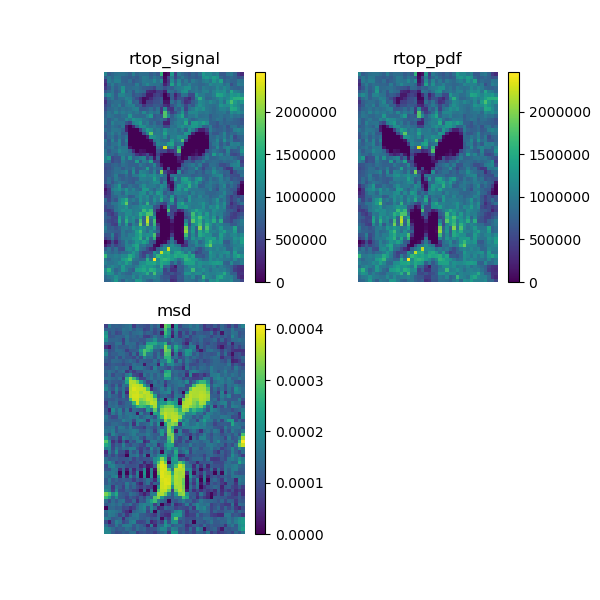Calculate SHORE scalar maps¶
We show how to calculate two SHORE-based scalar maps: return to origin probability (RTOP) [Descoteaux2011] and mean square displacement (MSD) [Wu2007], [Wu2008] on your data. SHORE can be used with any multiple b-value dataset like multi-shell or DSI.
First import the necessary modules:
import nibabel as nib
import numpy as np
import matplotlib.pyplot as plt
from dipy.data import fetch_taiwan_ntu_dsi, read_taiwan_ntu_dsi, get_sphere
from dipy.data import dsi_voxels
from dipy.reconst.shore import ShoreModel
Download and read the data for this tutorial.
fetch_taiwan_ntu_dsi()
img, gtab = read_taiwan_ntu_dsi()
img contains a nibabel Nifti1Image object (data) and gtab contains a GradientTable object (gradient information e.g. b-values). For example, to read the b-values it is possible to write print(gtab.bvals).
Load the raw diffusion data and the affine.
data = img.get_data()
affine = img.affine
print('data.shape (%d, %d, %d, %d)' % data.shape)
Instantiate the Model.
asm = ShoreModel(gtab)
Let’s just use only one slice only from the data.
dataslice = data[30:70, 20:80, data.shape[2] // 2]
Fit the signal with the model and calculate the SHORE coefficients.
asmfit = asm.fit(dataslice)
Calculate the analytical RTOP on the signal that corresponds to the integral of the signal.
print('Calculating... rtop_signal')
rtop_signal = asmfit.rtop_signal()
Now we calculate the analytical RTOP on the propagator, that corresponds to its central value.
print('Calculating... rtop_pdf')
rtop_pdf = asmfit.rtop_pdf()
In theory, these two measures must be equal, to show that we calculate the mean square error on this two measures.
mse = np.sum((rtop_signal - rtop_pdf) ** 2) / rtop_signal.size
print("MSE = %f" % mse)
MSE = 0.000000
Let’s calculate the analytical mean square displacement on the propagator.
print('Calculating... msd')
msd = asmfit.msd()
Show the maps and save them to a file.
fig = plt.figure(figsize=(6, 6))
ax1 = fig.add_subplot(2, 2, 1, title='rtop_signal')
ax1.set_axis_off()
ind = ax1.imshow(rtop_signal.T, interpolation='nearest', origin='lower')
plt.colorbar(ind)
ax2 = fig.add_subplot(2, 2, 2, title='rtop_pdf')
ax2.set_axis_off()
ind = ax2.imshow(rtop_pdf.T, interpolation='nearest', origin='lower')
plt.colorbar(ind)
ax3 = fig.add_subplot(2, 2, 3, title='msd')
ax3.set_axis_off()
ind = ax3.imshow(msd.T, interpolation='nearest', origin='lower', vmin=0)
plt.colorbar(ind)
plt.savefig('SHORE_maps.png')

RTOP and MSD calculated using the SHORE model.¶
References¶
- Descoteaux2011
Descoteaux M. et al., “Multiple q-shell diffusion propagator imaging”, Medical Image Analysis, vol 15, No. 4, p. 603-621, 2011.
- Wu2007
Wu Y. et al., “Hybrid diffusion imaging”, NeuroImage, vol 36, p. 617-629, 2007.
- Wu2008
Wu Y. et al., “Computation of Diffusion Function Measures in q-Space Using Magnetic Resonance Hybrid Diffusion Imaging”, IEEE TRANSACTIONS ON MEDICAL IMAGING, vol. 27, No. 6, p. 858-865, 2008.
Example source code
You can download the full source code of this example. This same script is also included in the dipy source distribution under the doc/examples/ directory.
